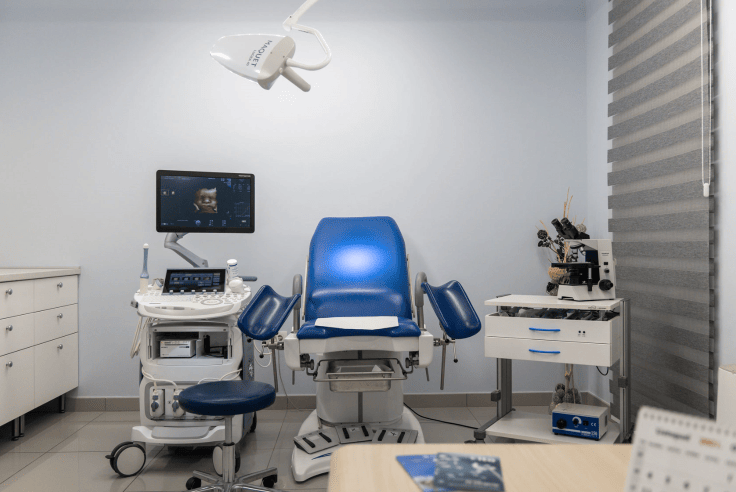Hysteroscopy is a minimally invasive method. It uses a small tube (Hysteroscope) with a light and a camera at the end of the tube. This allows us a detailed view of the uterus and a display of pathology.
The most common applications of hysteroscopy are:
- Diagnostic hysteroscopy for the purpose of identification of pathology in the uterus
- Endometrial biopsy
- Removal of polyps, fibroids, scars (Asherman’s syndrome), and septum
Removal of fibroids and polyps
Hysteroscopy is the ideal method for removing polyps and fibroids inside the uterus. The aforementioned procedures are routinely performed today and represent the gold standard in the treatment of fibroids and polyps inside the uterus.
Hysteroscopy and IVF
Hysteroscopy is one of the tools that can help us in the treatment of infertility. In a certain number of patients, hysteroscopy is the method of choice in the treatment of infertility. it will help us check whether the uterus is healthy enough for the implantation and growth of the embryo. We perform the most commonly mentioned procedure in the following conditions.
- Diagnostic hysteroscopy. If during the hysteroscopy we notice something that could cause problems with pregnancy, we will help you with the treatment options for the said problem
- Removal of fibroids and polyps inside the uterus
- Removal of scars in the uterus (Asherman’s syndrome) caused by previous procedures such as curettage
- Resection of congenital defects in the uterus such as the sputum
- “Scratching” of the endometrium: this method has proven to be effective in patients with repeated implantation failure
Hysteroscopy vs Laparoscopy
The mentioned methods are minimally invasive approaches that are used to diagnose and treat pathological conditions in the reproductive organs. Unlike laparoscopy, hysteroscopy does not require any incisions but uses the natural opening in the cervix to access the uterus.
Laparoscopy, on the other hand, requires two or more incisions (10 mm and 5 mm) in order to obtain a view of the abdominal cavity.
What to expect during a procedure?
There are two types of anesthesia used in hysteroscopy.
If it is a diagnostic hysteroscopy, only local anesthesia, and sedation is required. In the case of hysteroscopic procedures where fibroids and polyps are removed, it is recommended to perform them under short-term general anesthesia.
At the Cito Polyclinic, which is equipped with an operating room, we offer both forms of anesthesia under the supervision of our anesthesiologist.
Hysteroscopy under local anesthesia does not require special preparation, but if you decide to undergo hysteroscopy under general anesthesia, you need:
- Do not consume food and drink the evening before the procedure. If the procedure is performed in the afternoon, you must not drink anything 4 hours before the procedure and do not eat anything 8 hours before the procedure.
- If you are taking medication, our anesthesiologist will give you instructions on what to take/not to take before the procedure itself
How long does it take?
Depending on the reason for which the hysteroscopy procedure is performed, it can take a different amount of time:
- Diagnostic hysteroscopy: 10-20 min
- Removal of uterine polyps: 20-30 min
- Removal of fibroids in the uterus: Depending on the size of the fibroids, the procedure can last 45 minutes to 2 hours
In which part of the cycle is the best to do a hysteroscopy?
The most ideal time to perform a hysteroscopy is immediately after the end of menstrual bleeding. This is usually 6-10 days from the beginning of the cycle (the first day of the cycle is the beginning of menstrual bleeding).
Recovery from the hysteroscopic procedure
Hysteroscopic procedures belong to the so-called “Day surgery” and patients are discharged to home care on the same day. After the procedure, patients are accommodated in one of our suites for recovery under the supervision of our staff. When the patient feels well and our doctors are satisfied with the postoperative recovery, the patient is discharged to home care.
Pain after hysteroscopy
A few hours after the hysteroscopy, it is normal to have mild abdominal cramps. The day after surgery, most patients do not have severe pain and return to their daily activities the very next day. If the procedure is performed under general anesthesia, it takes a few days for complete recovery.
Sexual relations after the procedure
It is advised to avoid sexual intercourse for 2 weeks after the procedure.
The tool we use
In Policlinica Cito you can find the most modern hysteroscope frime Olympus, which uses the most advanced technology of bipolar current. It enables us to solve the most complicated hysteroscopic procedures with an emphasis on patient safety.


